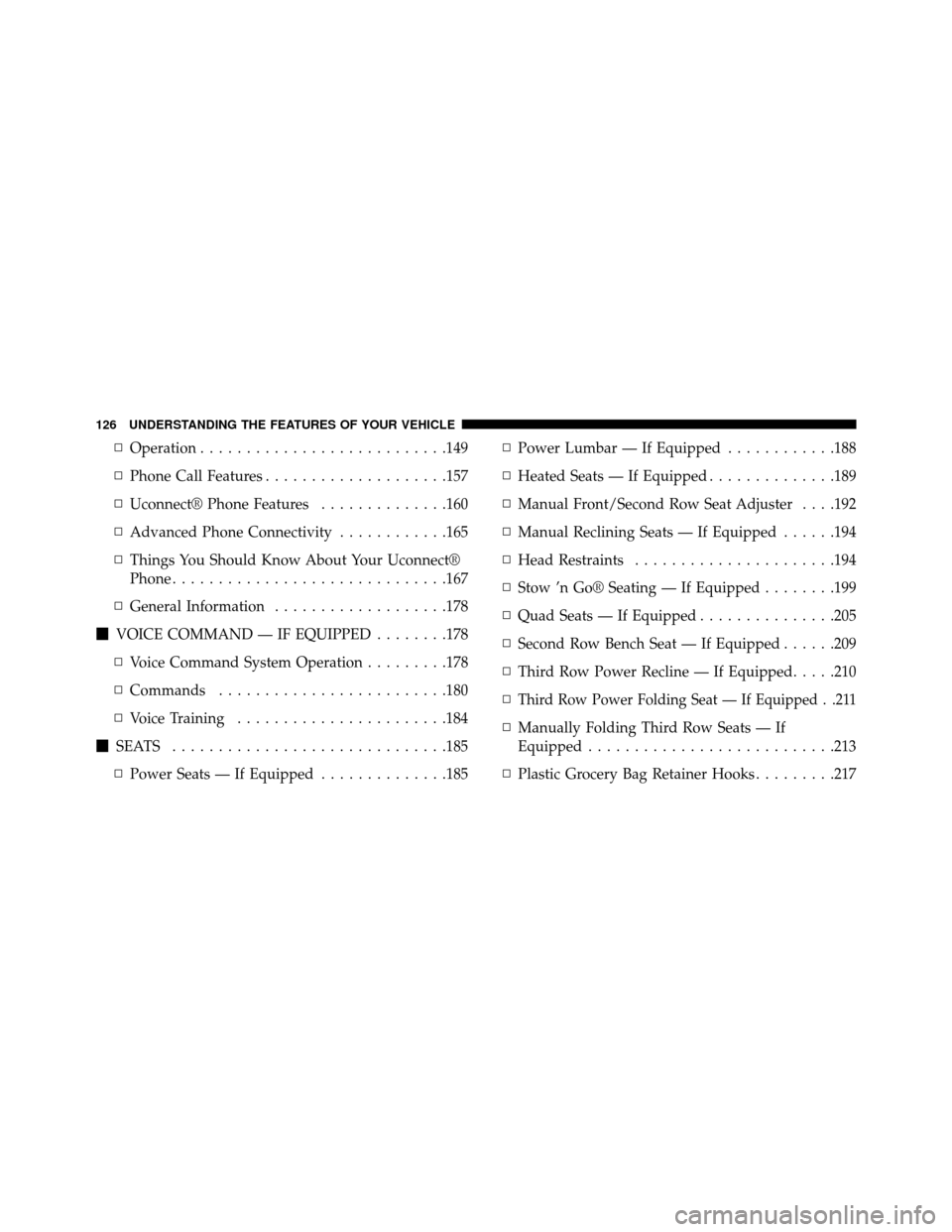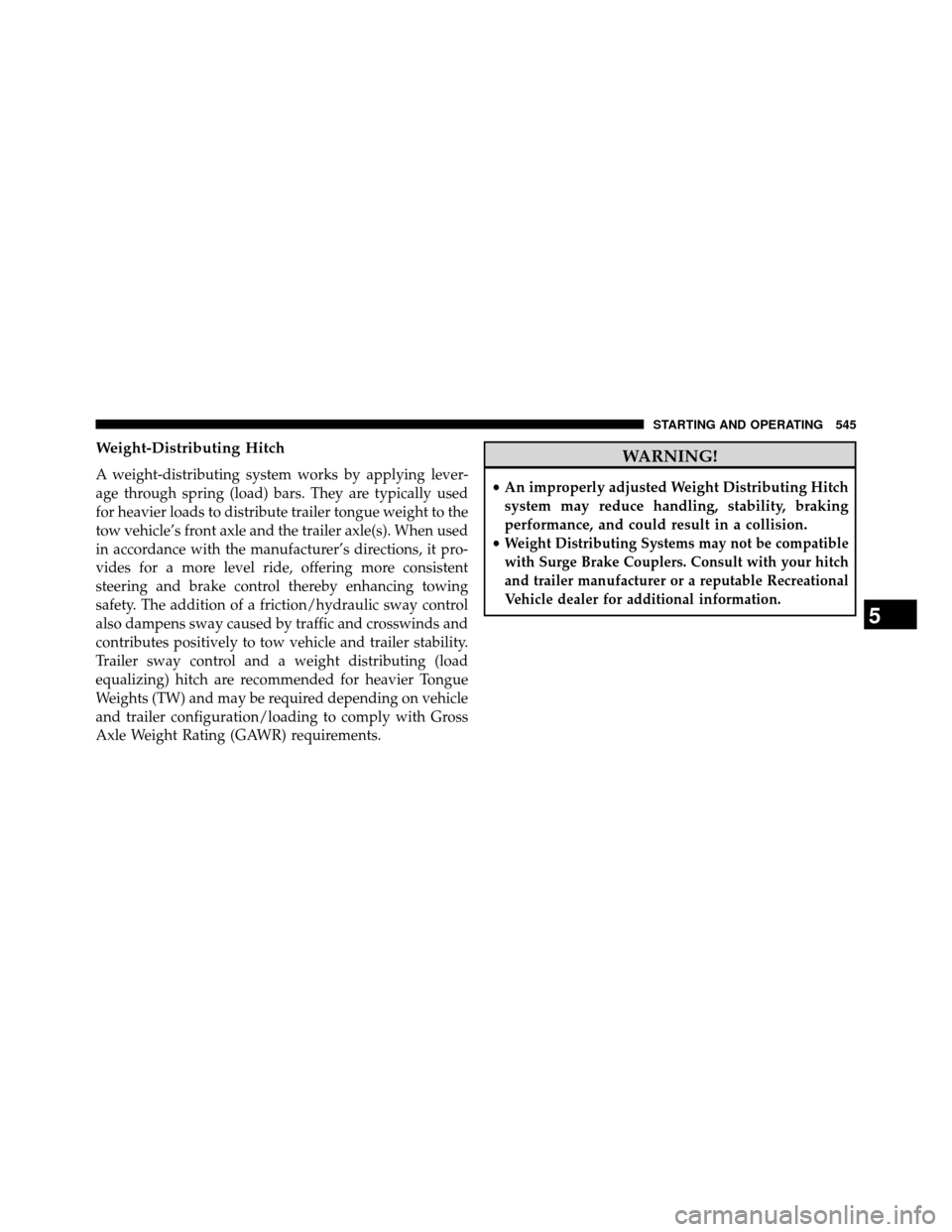Page 128 of 698

▫Operation ...........................149
▫ Phone Call Features ....................157
▫ Uconnect® Phone Features ..............160
▫ Advanced Phone Connectivity ............165
▫ Things You Should Know About Your Uconnect®
Phone ..............................167
▫ General Information ...................178
� VOICE COMMAND — IF EQUIPPED ........178
▫ Voice Command System Operation .........178
▫ Commands .........................180
▫ VoiceTraining .......................184
� SEATS ..............................185
▫ Power Seats — If Equipped ..............185▫
Power Lumbar — If Equipped ............188
▫ Heated Seats — If Equipped ..............189
▫ Manual Front/Second Row Seat Adjuster ....192
▫ Manual Reclining Seats — If Equipped ......194
▫ Head Restraints ......................194
▫ Stow ’n Go® Seating — If Equipped ........199
▫ Quad Seats — If Equipped ...............205
▫ Second Row Bench Seat — If Equipped ......209
▫ Third Row Power Recline — If Equipped .....210
▫
Third Row Power Folding Seat — If Equipped . .211
▫ Manually Folding Third Row Seats — If
Equipped ...........................213
▫ Plastic Grocery Bag Retainer Hooks .........217
126 UNDERSTANDING THE FEATURES OF YOUR VEHICLE
Page 301 of 698

CAUTION!
Failure to follow these cautions can cause damage to
the heating elements:
•Use care when washing the inside of the rear
window. Do not use abrasive window cleaners on
the interior surface of the window. Use a soft cloth
and a mild washing solution, wiping parallel to the
heating elements. Labels can be peeled off after
soaking with warm water.
• Do not use scrapers, sharp instruments, or abrasive
window cleaners on the interior surface of the
window.
• Keep all objects a safe distance from the window.
LOAD LEVELING SYSTEM — IF EQUIPPED
The automatic load leveling system will provide a level-
riding vehicle under most passenger and cargo loading
conditions. A hydraulic pump contained within the shock absorbers
raises the rear of the vehicle to the correct height. It takes
approximately 1 mile (1.6 km) of driving for the leveling
to complete depending on road surface conditions.
If the leveled vehicle is not moved for approximately 15
hours, the leveling system will bleed itself down. The
vehicle must be driven to reset the system.
ROOF LUGGAGE RACK — IF EQUIPPED
The crossbars on your vehicle are delivered stowed
within the roof rack side rails. If adding cargo, deploy the
crossbars. Distribute cargo weight evenly on the roof rack
crossbars, to maximum of 150 lbs (68 kg). The roof rack
does not increase the total load carrying capacity of the
vehicle. Be sure the total load of cargo inside the vehicle
plus that on the external rack does not exceed the
maximum vehicle load capacity.
3
UNDERSTANDING THE FEATURES OF YOUR VEHICLE 299
Page 302 of 698
The crossbars and side rails are designed to carry weight
on vehicles equipped with a luggage rack. The load must
not exceed 150 lbs (68 kg), and should be uniformly
distributed over the luggage rack crossbars.NOTE:
•
Crossbars are error-proofed and cannot be deployed or
stowed in the incorrect positions.
• To help control wind noise, stow the crossbars in the
side rails when they are not in use.
Deploying The Crossbars
To deploy the crossbars, completely loosen the thumb
screws at both ends of the crossbar and lift the crossbar
from its stowed position in the side rail. Repeat with
crossbar on the opposite side.
Crossbar Stowed In Side Rail
300 UNDERSTANDING THE FEATURES OF YOUR VEHICLE
Page 303 of 698
CAUTION!
Use care when removing and handling the crossbars
to prevent damage to the vehicle.Bend the crossbar supports at each end, taking care to
keep hand clear of pivoting joint. Slide the thumb screw
down.
Loosening Crossbars
Stowed Position
3
UNDERSTANDING THE FEATURES OF YOUR VEHICLE 301
Page 305 of 698
Make sure the directional arrows on the crossbars align
with the directional arrows on the side rails. Set the
crossbars into the deployed positions.
Once the crossbars are set into position, tighten the
thumb screws completely.
Stowing The Crossbars
Reverse the procedure to stow the crossbars, again,
taking care to keep hand clear of pivoting joint. Crossbars
are identical and can be stowed in either rail nest. Once
the crossbars are stowed, tighten the thumb screws
completely.Crossbar To Side Rail Installation
Tightening Crossbar
3
UNDERSTANDING THE FEATURES OF YOUR VEHICLE 303
Page 547 of 698

Weight-Distributing Hitch
A weight-distributing system works by applying lever-
age through spring (load) bars. They are typically used
for heavier loads to distribute trailer tongue weight to the
tow vehicle’s front axle and the trailer axle(s). When used
in accordance with the manufacturer’s directions, it pro-
vides for a more level ride, offering more consistent
steering and brake control thereby enhancing towing
safety. The addition of a friction/hydraulic sway control
also dampens sway caused by traffic and crosswinds and
contributes positively to tow vehicle and trailer stability.
Trailer sway control and a weight distributing (load
equalizing) hitch are recommended for heavier Tongue
Weights (TW) and may be required depending on vehicle
and trailer configuration/loading to comply with Gross
Axle Weight Rating (GAWR) requirements.
WARNING!
•An improperly adjusted Weight Distributing Hitch
system may reduce handling, stability, braking
performance, and could result in a collision.
•
Weight Distributing Systems may not be compatible
with Surge Brake Couplers. Consult with your hitch
and trailer manufacturer or a reputable Recreational
Vehicle dealer for additional information.
5
STARTING AND OPERATING 545
Page 602 of 698
TOWING A DISABLED VEHICLE
This section describes procedures for towing a disabled
vehicle using a commercial wrecker service.
Towing ConditionWheels OFF the Ground ALL MODELS
Flat Tow NONEIf transmission is operable:
•Transmission in NEUTRAL
• 25 mph (40 km/h) maxspeed
• 15 miles (24 km) maxdistanceWheel lift Rear
Front OK
Flatbed ALLBEST METHOD
Proper towing or lifting equipment is required to prevent
damage to your vehicle. Use only tow bars and other
equipment designed for this purpose, following equip-
ment manufacturer ’s instructions. Use of safety chains is
mandatory. Attach a tow bar or other towing device to main structural members of the vehicle, not to bumpers
or associated brackets. State and local laws regarding
vehicles under tow must be observed.
If you must use the accessories (wipers, defrosters, etc.)
while being towed, the ignition must be in the ON/RUN
position, not the ACC position.
600 WHAT TO DO IN EMERGENCIES